It's time to build a better boss monster. No longer will you have to endure your players poking at your monsters' ankles until their hit points are whittled away, and the creature dies from a fatal blow to its big toe. Instead, your heroes can search a near-invincible foe for a weakness, try to exploit it, and fight hard to keep striking the monster where it hurts as it tries to protect its vulnerability. This house rule is great for gaming groups that want a more dynamic and thoughtful D&D combat experience—perhaps your group has very few combat encounters and you want them to be meaningful, or perhaps your game has lots of battles and you want your boss encounters to stand out from the trash mobs.
Because of the prevalence of weak point mechanics in video games like The Legend of Zelda, Shadow of the Colossus, and literally hundreds of other examples, this house rule may make your D&D game feel more like a game than a simulation of fantasy life. This doesn’t have to be the case: fantasy and mythology are flush with stories of legendary warriors and monsters with fatal physical flaws. Consider Achilles and his famous heel from The Iliad, the heavily armored Imperial walkers that could only be defeated by ensnaring their legs in The Empire Strikes Back, and the mighty dragon Smaug’s only vulnerability in The Hobbit.
Before using this house rule in your game, consider telling your players outright that your boss monsters will have a weak point that they can seek out to make defeating it easier.
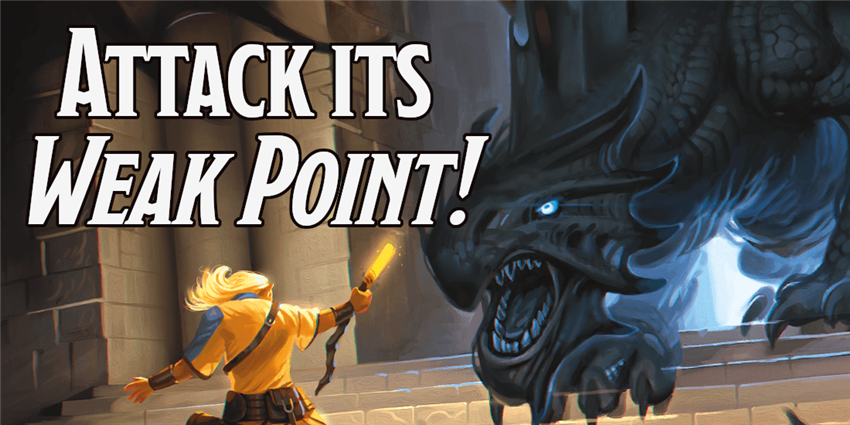
Attack Its Weak Point
The black dragon loomed above a fighter, a wizard, and a rogue, acid dripping from its scarred and twisted maw. “Death will come quickly… if you do not struggle,” it gleefully rasped. “Untevor the Sable has mercy upon compliant prey.”
The wizard desperately thought back to days in the academy long past, when she read the entirety of the Draconomicon from cover to cover in a weekend. “Untevor… the Sable… Oh!” She turned to the keen-eyed elven rogue that crouched beside her. “An old legend told by Skagri the Bard says that, in the Year of the Sundered Shield—”
“Get to the point!” the rogue hissed.
“Uh, Untevor the Sable has a scale tattooed with a rune of invulnerability! The source of his power! Can you find it?”
A line of acid exploded from the dragon’s mouth. The rogue moved almost before the blast left the beast's crackling maw, but the fighter and wizard only barely dodged in time. The fighter winced as a bright pink patch of burning flesh showed through his tunic, and tiny, sizzling pinholes sizzled all over their robes and armor. “Warrior!” shouted the rogue. “Get near the thing. Better to deal with its claws than its acid. I’ll look for the rune, and get your sword ready to carve the damn thing off!”
Some legendary monsters are nigh-invulnerable to attacks both physical and magical. However, despite being covered from head to foot in impenetrable scales, enchanted armor, or arcane tattoos, there is one tiny gap in their armor. A single weak point that their foes can exploit. This house rule was designed to only be applied to legendary monsters—that is, creatures that one or both of the following traits: Legendary Resistance or Legendary Actions. A full list of all legendary creatures can be found using the D&D Beyond Monsters tool. However, giving any monster 2 uses of the Legendary Resistance feature and two Legendary Action uses that it can use each turn (see Legendary Creatures in the Monster Manual) is enough to turn any monster that you want to use as a solo boss encounter into a legendary creature.
Invulnerablity
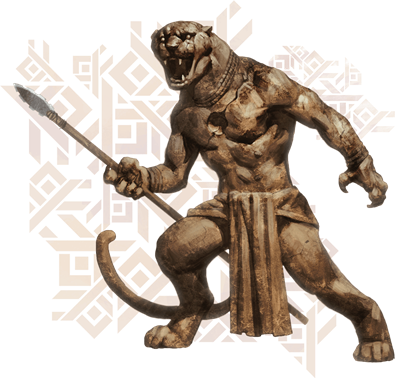 A legendary creature that uses this weak point house rule will be called an invulnerable creature throughout this article. An invulnerable creature gains the following benefits:
A legendary creature that uses this weak point house rule will be called an invulnerable creature throughout this article. An invulnerable creature gains the following benefits:
- It is immune to bludgeoning, piercing, and slashing damage, in addition to its other damage immunities.
- It is resistant to all other forms of damage.
If the creature would gain immunity to a damage type it's already resistant to, the new immunity supersedes its resistance.
Weak Points
An invulnerable creature also has a weak point somewhere on its body that, if attacked, bypasses the creature’s damage resistances and immunities, and may even confer an additional drawback.
Finding the Weak Point. Identifying a creature’s weak point requires you to take the Search action to physically examine the monster. Make a Wisdom (Perception) or Intelligence (Investigation) check (DM’s choice) with a DC equal to 8 + the creature’s challenge rating. On a success, you identify the creature’s weak point. Once the weak point has been identified, you can tell your allies about it (no action required). Only a creature that knows the precise location of a creature’s weak point can attack it.
Legends of the Weak Point. Some invulnerable creatures are so infamous that legends are told of their greatness—and of their fatal weakness. If such a legend exists (at the DM’s discretion), you can use your action to make an Intelligence check with a DC equal to 8 + the creature’s challenge rating. Your DM may allow you to apply your proficiency in the Arcana, History, Nature, or Religion skill depending on the nature of the creature. On a success, you and any creatures that you tell of the legend have advantage on Wisdom (Perception) and Intelligence (Investigation) checks to identify the weak point.
Attacking the Weak Point. Once you’ve identified an invulnerable creature’s weak point, you can target it with a weapon or spell attack. The weak point has the same Armor Class as the invulnerable creature. In order to attack the weak point, you must take a –5 penalty to hit the small target. If the attack hits, it ignores the invulnerable creature’s damage resistances and immunities and deals an additional 10 damage. An attack against a monster’s weak point may also confer additional benefits, as described in “Variant Weak Points,” below.
However, some monsters’ weak points are obvious, like a beholder’s eye. If you can guess a creature’s weak point outright, and the DM determines that it’s trivial to spot the weak point, you can attack it without making a check to identify it. You still must take a –5 penalty to hit the small target. If your guess is correct, you gain the benefits of attacking the weak point (see “Attacking the Weak Point,” below). If your guess is incorrect, the attack is made against the invulnerable creature as normal.
Rules Tip: Attacks Only
Be aware that only attacks can affect a creature’s weak point. Effects that deal damage but don’t require an attack roll, such as spells or magical effects that require a saving throw, can’t specifically affect a creature’s weak point.
Self-Defense
Once a monster realizes its weak point is being targeted, it does its best to cover it. A beholder might partially close its central eye so that only a tiny slit remains for it to peer through, or a dragon might land and wrap one wing around the vulnerable soft patch in its chest. An invulnerable creature can use one of its legendary actions (or a bonus action on its turn) to cover the weak point until the start of its next turn.
Most creatures that cover their own weak point are able to grant that point three-quarters cover (note that this increases the AC of the weak point, making it even harder to hit). However, some creatures might be able to completely cover a weak point, or only cover a small portion of it, granting that point total cover or half cover at the DM’s discretion. If a weak point has total cover, the DM should include a way to remove that cover, such as by stunning or frightening the creature. Also at the DM's discretion, a creature covering its weak point might not be able to fight as effectively or take certain actions.
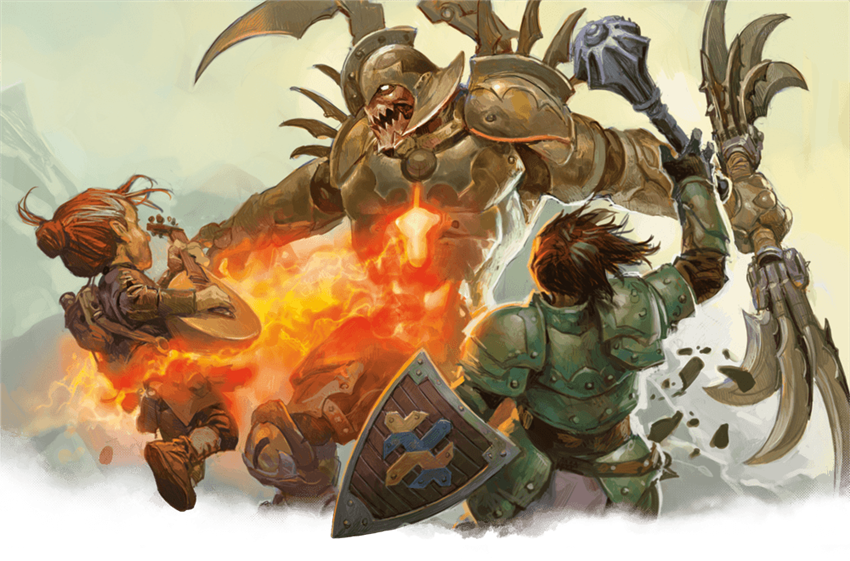
Variant Weak Points
The rules presented above are the core of this house rule. However, this system is designed to be incredibly flexible, allowing you to create monsters with many varied types of weak points to suit the story you want to tell. Consider using these variants on the rules presented above to keep your boss encounters from becoming rote.
Staggering Weak Point
This variant allows an attack against a creature’s weak point to bypass its damage immunities and resistances as normal, but doesn’t deal an additional 10 damage. Instead, the creature gains a condition that reduces its ability in combat. A beholder struck in its central eye might be blinded until the start of its next turn as a protective mucus forms. The best conditions for the DM to impose for striking a weak point are blinded, deafened, poisoned, and prone, since their effects are relatively minor.
The stunned condition can be applied, but only if it lasts until the start of the invulnerable creature’s turn. This lets the characters take advantage of the defensive penalties of the stunned condition, but without skipping the invulnerable creature’s next turn.
Weak Point Without Invulnerability
This variant changes the benefits of becoming an invulnerable creature. Instead of granting the creature the usual benefits of becoming invulnerable, maximize the creature’s hit points. For instance, an aboleth typically has 135 hit points, which is equal to the average of its hit dice (18d10) plus 36 (its Constitution modifier of +2 applied to each of its 18 hit dice). Instead of averaging its hit dice, maximize them for a result of 216 (180 + 36) hit points.
This alternative method makes it just as viable to damage the creature normally, but introduces a new location that makes it easier to defeat your foe. Perhaps this weak point is a runic sigil of vitality that was drawn by a shaman upon the creature’s skin, and the source of the magic is its weakest point.
Removable Invulnerability
This variant gives a weak point its own set of hit points. Once this weak point is destroyed, all of the benefits of invulnerability granted to the invulnerable creature are dispelled. In this case, the weak point should have hit points equal to about one-third of the monster’s hit point maximum. And as usual, the weak point isn’t subject to the damage resistances or immunities granted by being an invulnerable creature.
For example, an adult black dragon with a magical sigil of invincibility inscribed upon one of its innumerable scales is an invulnerable creature so long as the ensigiled scale is attached to its body. The dragon has 195 hit points, so cleaving the scale from the dragon’s body requires 65 points of damage be dealt to the weak point. Once it’s gone, its magic fades completely and the dragon can be damaged normally.
Recovering Invulnerability. As an additional variant, a monster could have a destructible weak point that recovers all of its hit points when certain conditions are met. A red dragon could inscribe a new rune of protection upon itself, thus restoring its weak point to full hit points, whenever it uses its Fire Breath. In this case, the weak point should have significantly fewer hit points; approximately one-sixth the invulnerable creature’s maximum hit points. To make the fight even more challenging, the weak point could appear on a different part of the creature's body whenever it is recovered.
Sequential Weak Points
This variant allows you to create creatures with multiple weak points. This variant works best with Gargantuan creatures, like ancient dragons or the legendary tarrasque, where their incredible size can make reaching any one specific weak point a challenge. A creature with three weak points may have only one be active at the beginning, and then have its other weak points activate sequentially as the creature takes damage—which in turn causes previous weak points to be destroyed or be sealed shut, granting them total cover. Divide the invulnerable creature’s hit points into a number of segments equal to the number of weak points it has, with one weak point being destroyed and a new one activating whenever one segment of the creature’s hit points is exhausted.
For example, a tarrasque with a weak point on its tail would require a party to attack it from behind until that weakness was exhausted and a new weak point activates between its shoulder blades. This new weak point would require the characters to get on the titan’s back in order to damage it. This gives your fight a sense of progression and requires you to react dynamically to the changing situation.
Multiple Active Weak Points. Alternatively, all of the creature’s weak points could be active at once. Once one of these weak points takes damage equal to one segment of the creature’s maximum hit points, it closes. For example, consider a tarrasque that has one weak point on all four of its legs that are open at once, and one on its head, which can only be damaged once all four of its legs are defeated. Each weak point can only take damage equal to 1/5 of the tarrasque’s maximum hit points before closing and becoming immune to damage. This requires you to choose between focusing fire or dividing your forces to conquer more of the creature at once.
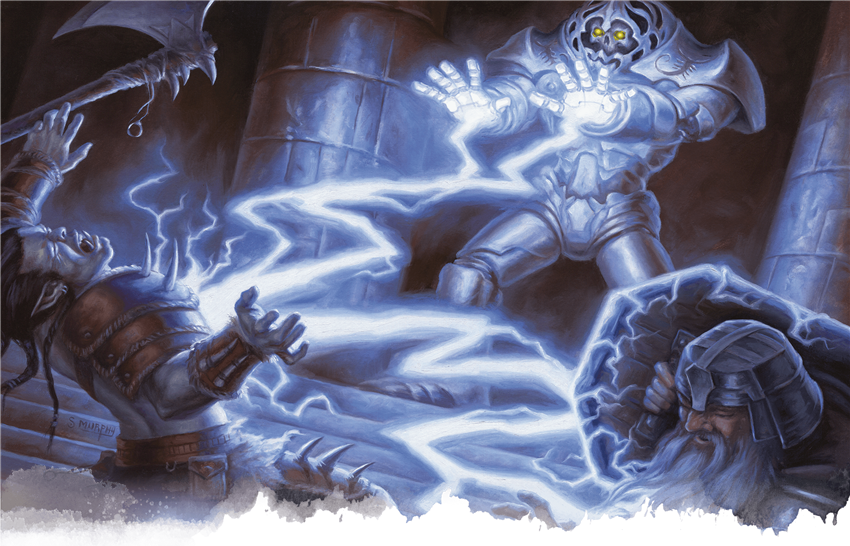
Challenges
With the house rule itself explained, let’s address challenges that you may encounter when implementing it, and how you can avoid them.
The “Called Shot” Problem
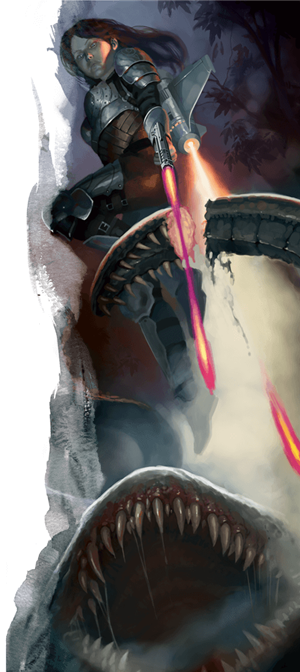 Many D&D players encounter problems when implementing a called shot mechanic—that is, a mechanic that allows them to target a specific part of a foe rather than just attacking the foe itself—because it breaks the standard assumptions of D&D.
Many D&D players encounter problems when implementing a called shot mechanic—that is, a mechanic that allows them to target a specific part of a foe rather than just attacking the foe itself—because it breaks the standard assumptions of D&D.
D&D’s combat is an abstraction. The concepts of attack bonuses, Armor Class, and hit points are particularly nebulous in order to make combat faster. Attack bonuses and Armor Class in particular always assume that the attacker is using the most powerful part of their weapon to attack the most vulnerable part of the defender. Likewise, it’s easy to think of hit points as the amount of literal sword cuts in their flesh a creature can take before keeling over dead. Called shot systems tend to break the realism of D&D’s abstract combat.
Imagine a character making a called shot at an ogre’s head, shooting an arrow clean through its skull, and then having the attack only deal a paltry amount of extra damage. Then imagine doing that three turns in a row, practically turning the creature’s skull into a sieve. How is that ogre still alive? Or, on the other hand, imagine a headshot actually working as an instant kill, allowing a 1st-level character to effectively deal 59 damage in a single shot to a full-health ogre.
This house rule suffers somewhat from the same problems as any subsystem that lets you target a specific point on a creature’s body. However, problems are mitigated by restricting how broadly it can be used: only certain monsters have specific weak points, and giving a monster a weak point also gives it increased defenses elsewhere. This puzzle-solving element specifically enhances boss encounters, rather than modifying every minor encounter in the game.
If you or your players are having trouble reconciling additional damage from called shots (the “headshot” problem, above), remember that hit points aren’t solely vitality. They’re an abstract representation of “physical and mental durability, the will to live, and luck.” Hitting a monster’s weak point may not have done much damage physically, but the power behind the blow could have winded the creature or left it shaken. On the other hand, a monster’s weak point might be much harder to pierce than a human’s skin! It’s easy to imagine a beholder’s eye or a lich’s exposed, necrotically-animated heart being as tough as a bulletproof vest. It’s a mythical monster, after all!
Determining Challenge Rating
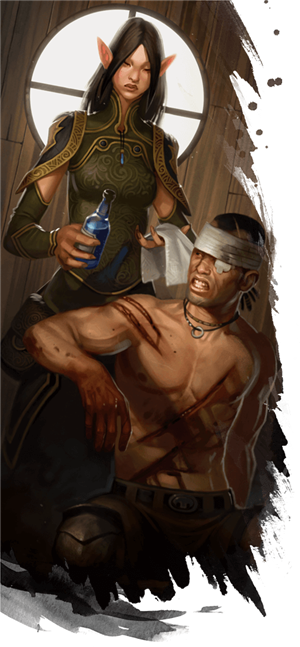 This subsystem has the chance to make an invulnerable creature much more challenging (or much easier, depending on how adept your characters are at identifying a creature’s weak point) than the legendary creature it was based on. As a rule of thumb, treat the invulnerable creature as the same challenge rating as the legendary creature it was based on; the advantages of its heightened defenses are generally canceled out by its new weaknesses.
This subsystem has the chance to make an invulnerable creature much more challenging (or much easier, depending on how adept your characters are at identifying a creature’s weak point) than the legendary creature it was based on. As a rule of thumb, treat the invulnerable creature as the same challenge rating as the legendary creature it was based on; the advantages of its heightened defenses are generally canceled out by its new weaknesses.
The first time you use this house rule, you may wish to treat the invulnerable creature’s CR as if it were 2 higher than the legendary creature it was based on. This is due to the fact that your players may waste some of their attacks flailing uselessly against the invulnerable creature’s hide before picking up on what’s going on. If you see this happening, you may not have provided enough information to your players—or you presented it too subtly.
A way to get around this might be to include minion creatures with very obvious weak points in the dungeon leading up to this creature; undead with exposed hearts, constructs with exposed wiring, or spiders with giant single eyeballs—all glowing targets for one-hit kills against these pathetic monsters. Now that your players have learned that monsters can have weak points, they might reach the conclusion that their greatest foes have hidden locations that can be specifically targeted to deal massive damage.
What Weak Points Can I Use?
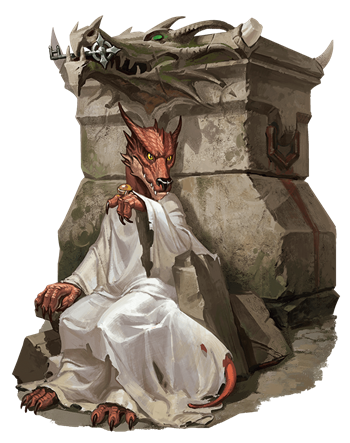 Not all legendary creatures have weak points as obvious as a beholder’s central eye. Most legendary creatures in D&D are actually humanoids with particularly powerful magic. When creating an invulnerable creature from a monster that doesn’t have any obvious anatomical weak points (other than, say, its head), what are some other options?
Not all legendary creatures have weak points as obvious as a beholder’s central eye. Most legendary creatures in D&D are actually humanoids with particularly powerful magic. When creating an invulnerable creature from a monster that doesn’t have any obvious anatomical weak points (other than, say, its head), what are some other options?
- A magically enlarged body part, such as an eye, hand, nose, or mouth, or a mechanical crab claw.
- A magical rune, about two inches in diameter, hidden somewhere on its body that powers a spell of invulnerability.
- Armor straps on a creature covered head to toe in armor; attacking these straps causes the armor to fall off in pieces.
- A spiritual core that maintains the creature’s physical form, like a heart of ice inside the water elemental princess Olhydra, or a talisman hidden in a mummy lord’s wrappings.
- An old wound carved in a demon lord’s chest by Zariel’s holy blade.
- A stone golem with a deep crack in its back hidden by a tapestry it wears like a cape.
- A warlock so closely bonded to their familiar that they share one another's life force; only wounding the familiar can wound the warlock.
- A magical ring of invulnerability worn upon the creature's finger, with amber light spilling from its enchanted gemstone.
What do you think of this house rule? Would you use it in your home game? What other variant weak points can you think of?
I mused about this topic on Twitter in December 2019. This article is based off of the stray thoughts I proposed and the feedback I received in that original Twitter thread.
Create A Brand-New Adventurer Acquire New Powers and Adventures Browse All Your D&D Content
 James Haeck is the lead writer for D&D Beyond, the co-author of Waterdeep: Dragon Heist, Baldur's Gate: Descent into Avernus, and the Critical Role Explorer's Guide to Wildemount, a member of the Guild Adepts, and a freelance writer for Wizards of the Coast, the D&D Adventurers League, and other RPG companies. He lives in Seattle, Washington with his fiancée Hannah and their animal companions Mei and Marzipan. You can find him wasting time on Twitter at @jamesjhaeck.
James Haeck is the lead writer for D&D Beyond, the co-author of Waterdeep: Dragon Heist, Baldur's Gate: Descent into Avernus, and the Critical Role Explorer's Guide to Wildemount, a member of the Guild Adepts, and a freelance writer for Wizards of the Coast, the D&D Adventurers League, and other RPG companies. He lives in Seattle, Washington with his fiancée Hannah and their animal companions Mei and Marzipan. You can find him wasting time on Twitter at @jamesjhaeck.








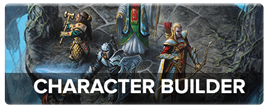
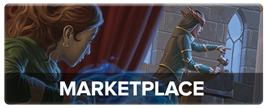
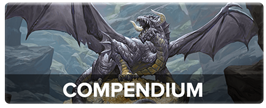
-
View User Profile
-
Send Message
Posted Jan 30, 2020Interesting concept. Called shot rules tend to be problematic, though. Either they're too difficult, in which case they're kinda pointless, or they're too easy to perform which makes fights unbalanced (and also steals the thunder from Sharpness and Vorpal swords).
-
View User Profile
-
Send Message
Posted Jan 30, 2020I am thinking of a version of this where the creature simple has resistance to damage, and hitting the weak spot deals normal damage. If the weak spot has been damaged for 1/4 of the monster's max hp, it breaks the resistance.
-
View User Profile
-
Send Message
Posted Jan 30, 2020To clarify, does hitting a weak point also deal damage to the boss when it has multiple ones, like in the Tarrasque example? Or would the party have to knock out a weak point, then hit the boss, then another weak point, etc? I feel like it's the first one, because if it's the second then essentially the boss has double it's normal HP. I just want to clarify because this is a really cool rule I want to use. Could even scale it down a bit to get it to work as a decent enough called shot mechanic for normal mobs.
-
View User Profile
-
Send Message
Posted Jan 30, 2020This is sooooo cool
-
View User Profile
-
Send Message
Posted Jan 30, 2020I really like this, as someone who runs monster hunter campaigns occasionally. as for the "headshot" problem, I don't always count hp as life or vigor, but sometimes as stamina, or luck. "Hits" are attacks that almost land, but the opponent is able to barely dodge or block, until their HP; their stamina runs out. Then the hit that reduces a creature to 0HP is a hit that landed, and was a mortal blow. This helps me make combat seem more deadly when I have humanoid characters and creatures fighting. Rather than using terms like "wounded" or "bleeding heavily" to describe creatures and their approximate HP, I may describe hits on lower HP creatures as "shallow cuts" or "glancing blows", showing that the opponent is slowing down and tiring out. (Do let you players know that you are doing this, so they don't think you're having them fight a creature with ridiculously high AC)
-
View User Profile
-
Send Message
Posted Jan 30, 2020It's the first one.
-
View User Profile
-
Send Message
Posted Jan 30, 2020I strongly disagree - It's up to you as the DM what/where the weak point is and what the conditions are for attacking it, so you can tailor it to your party pretty easily.
I'd also strongly encourage you to put it in a 'tough to reach' spot rather than rule that out as too hard for them - if they can't climb up with athletics they'll have to find some other way - knock the thing over, find some high ground (which you can make sure is there.. cos you're the DM!). Maybe during a legendary action, the monster ends up exposing the weak point briefly. If they all hold their actions and wait for it, BAM they can take the thing down. Hard-earned victories taste sweet.
If they are cake-walking all of your encounters that use this, then consider using the "Self Defence" section more liberally.. make the weak spot harder to spot or harder to hit. Neutralise whatever they are using to hit it. Magic Missile? "This one is invulnerable to force damage."
This house rule is great because it gives DM's tools to alter their game a bit and add a new element, but it still gives them options for how it will work best for them. In fact, this is probably the best article I've seen on DND Beyond.
-
View User Profile
-
Send Message
Posted Jan 30, 2020The concept is awesome, but personally I would tweak it a bit. Allowing the characters make an intelligence check on the spot feels like this is just additional mechanics and extra actions to take in the battle to lengthen it instead of adding to the story. I would completely forgo that option, and instead focus on the research. For each successful day of research the characters could choose one of the following "boons" as preparation for the upcoming battle:
Successful research would require to search in places that has the information, of course, which can lead to adventures of course. You can limit the total amount of boons to be able to gather by information; or some of the boons could be tied to specific items they need to acquire.
This way instead of feeling like the creatures are now harder to defeat because they need to take additional actions in the beginning of the combat just to be able to deal damage, it would depend on the characters of how much time they take to gain the upper hand before seeking their enemy out - which is even more exciting if there is a timer, for example said creature is gathering an army to destroy the kingdom, or actively seeking out and trying to destroy the information that can be turned against them.
Also, regarding the called shot, most approaches I've seen before kinda fallen apart from the question "okay, but why would I use that if taking the Sharpshooter feat is way easier?"
-
View User Profile
-
Send Message
Posted Jan 30, 2020The creature's total HP is converted into the separate HPs of the weak points, not copied, so practically you don't even need to track the total, just the separate amounts; and the creature is defeated when all weak point's HP is reduced to 0.
If you want to add even more complexity and strategy to it, you could designate one "weak point" as the core, and each destroyed weak point could convert one or more damage type immunity to a resistance (or remove a resistance); and you only need to reduce the core to 0 HP to defeat the creature. This way the players have a choice for either aiming for the core (which is still harder to hit), or try to remove one more weak point (because only some of them has attacks that can damage the core) - so in short, go for a longer or a harder battle.
-
View User Profile
-
Send Message
Posted Jan 30, 2020Here's a few problems with the implementation:
-Immune to B/P/S but only resistant to other types of damage. Make martials eat dirt and only mildly inconvienience casters ([feat]Elemental Adept[/feat] is a thing) trying to fight it.
-No protection from negative conditions whatsoever except legendary resistance. So most casters and such have no incentive to change up their strategy.
-Martials still have to deal with the fact that they rarely have high Intelligence checks (maybe good Perception sometimes) and as another slap in the face, they have to deal with a bumped up AC that makes GWM/SS highly impractical (without which they can barely scratch legendary monsters).
-
View User Profile
-
Send Message
Posted Jan 30, 2020That doesn't make it a terrible rule. If your group lacks climbing ability, and you throw a creature at them that can only be defeated by climbing, and they wipe, then that's on you as DM. Obviously you have control over what they face, so use what you know about them to customize the encounter. Maybe the weak point could be on the belly instead, for example.
As for your steamrolling examples...I don't see the issue. Those look like cool strategies to come up with on the fly (no pun intended) to adapt. The point is to make fights more interesting than "surround it and hit it with swords until hp = 0". Give those toolbox characters a raison d'être.
-
View User Profile
-
Send Message
Posted Jan 30, 2020I’ve had a big Ancient entity running around my group’s campaign for a while now, and multiple sources have informed them that no “god, giant, dragon, or other ancient being has ever defeated it”. Up until now, I had no good way to make the fight interesting or difficult without just making him a hit points bag. And now I have the tools necessary to make him the ultimate boss monster! Thanks for these!
-
View User Profile
-
Send Message
Posted Jan 30, 2020I will so use this in baldurs gate.
-
View User Profile
-
Send Message
Posted Jan 30, 2020I don't think all of these are a problem because while mechanically it seems like only a small inconvenience to casters, it is worth considering the mind set that being Invulnerable puts a creature in. They are immune to B/P/S regardless of whether it's magical or not, so they don't need to care about the fighter or paladin rushing towards them. They can focus on getting up close to the casters, which no caster really wants such a creature to be focusing on them. Casters could focus on trying to hurl spells at half damage but being the only members of the party to hurt it, they are going to get focused and have little support from the party. On the other hand, a caster is also more likely to be able to remember or find the weak point and communicate that to the rest of the group at large.
Also, I don't think it's a slap in the face to Martial classes that they have to deal with bumped up AC, especially since that doing damage to a weak point adds 10 damage, just like GWM and SS.
-
View User Profile
-
Send Message
Posted Jan 30, 2020I like this so much! The modularity I think is really smart. Use this to spice up a battle. Also what I love about the idea of a legend is it gives a lot of meaning behind an earlier minor encounter with some chance of risk or failure.
I'm always looking for these to be more than just a plot gate. They can fail and still succeed in the encounter.
Some other things I might add:
In addition to an Intelligence check for a legendary weak spot
Another thing I could see adding to multiple weak points is assigning a 4 or 6 sided die to it. Heroes could try and strike the monster without trying to find the weak spot yet. For instance, the Ogre wears rune carved armor on his head, chest, arms, and legs. If the heroes hit without a called shot, roll, the dice, if the weak spot hasn't been disarmed at that point use invulnerability rules. Use things like spells and thievery skill to get in close to the ogre and attempt to get rid of his armor.
-
View User Profile
-
Send Message
Posted Jan 30, 2020...which means players who've spent their ASL to get those feats may feel like they are cheated out cause now others can also gain the same benefit just by passing a skill check.
-
View User Profile
-
Send Message
Posted Jan 30, 2020This is similar to a set of house rules I saw for making monster fights more Witcher-like. The upshot is that systems like this make fighting monsters more fairy-tale or legend-like. You're not just fighting a monster, you have to use knowledge and guile and apply hidden lore or folk-wisdom to defeat an otherwise nearly insurmountable foe. The 'Weak Point' listed here is just a minor example.
The weakness would be things like sure, a missing scale a-la Smaug, but could also be 'Only weapons dipped in stewed witchbane at dawn can pierce the flesh of the Annis Hag' or 'The Shadows That Eat Flesh' cannot bear the sound of hymns to Pelor, so singing them loud when you wander the forest, or the Shadows will leave you a bloody skinless corpse by morning' or something like that. It gives a great sense of atmosphere and makes the monsters seem so much more legendary and the lore of the world so much deeper. If the weak points are not 'called-shot' type weaknesses, you can avoid breaking the abstraction of D&D as well.
Another way to get around the Called Shot problem is to sure, allow the called shot, but it doesn't do any more damage that anything else, but it does apply status bonuses or eliminate a benefit the monster has. The ankheg sense you with their antennae. Cut them off to blind them. The called shot does no more damage than a usual attack, but it nulifies their Tremorsense. Things like that can work to make lore work in your favor without breaking the system.
-
View User Profile
-
Send Message
Posted Jan 30, 2020Since this is meant to be a one time thing, I don't think James Haeck felt the need to do all the corner cases. But any DM worth his salt can easily figure this one out:
Sharpshooter: Once you found the weakpoint being a sharpshooter means you are able to fire at the weakpoint without penalty
Great Weapon Master: Your massive weapon aids in you in hitting the weakpoint, if you take a -5 penalty to hit you do an extra 15(or 20) damage
-
View User Profile
-
Send Message
Posted Jan 30, 2020This is also fantastic, would love to see a breakdown of conditions a called shot could impose and how to balance them.
-
View User Profile
-
Send Message
Posted Jan 30, 2020Some players may feel this way, but consider: SS and GWM are already two of the best and most consistently useful feats in the game. Additionally, only specific boss encounter creatures have the weak point that allows anyone to gain a -5/+10 bonus; people with the feat can still use it against all other non-boss creatures while their allies can't.